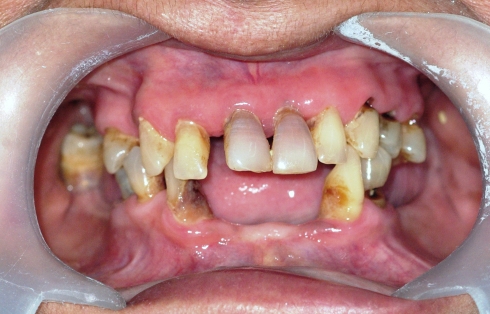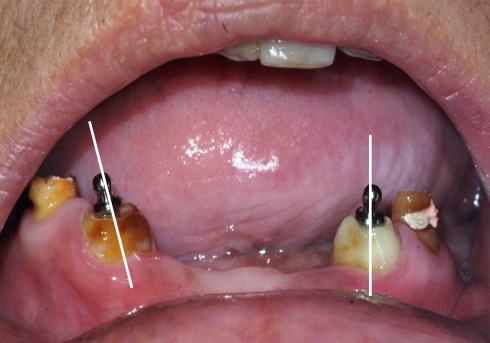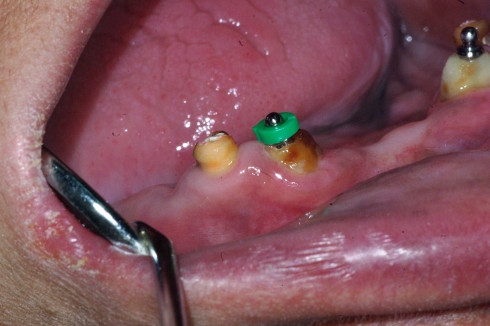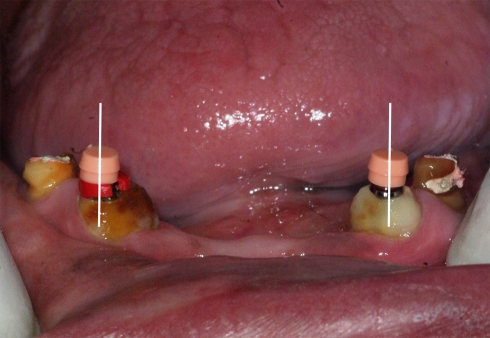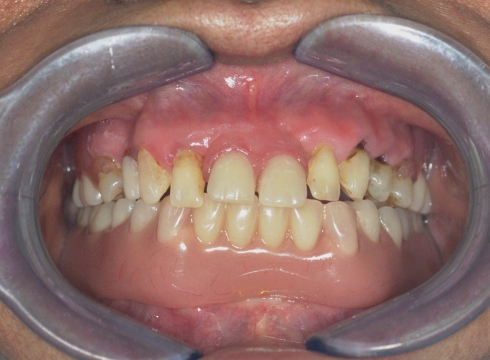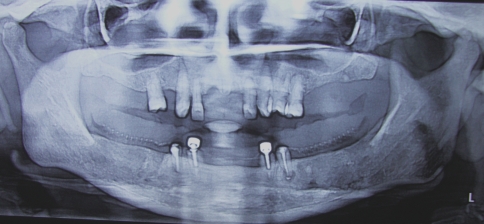Abstract
Precision attachments have been largely ignored by most dental professionals for trivial reasons such as cost and reluctance of a practitioner to grasp the intricacies of its indications and applications. Precision attachments offer considerable advantages such as increased retention of a denture, preservation of teeth which are otherwise indicated for extraction, as a viable alternative to implant retained overdenture and the ability to obtain parallelism in divergent abutments. A prosthodontist who familiarizes himself with precision attachments will be in a position to suggest a better treatment options in retaining teeth which might otherwise be considered for extraction or immediate implant placement. In this clinical report, we have described an overdenture placed on a previously unfavourable abutment made favourable by placing directional rings to maintain parallelism thus facilitating easy insertion and removal of the prosthesis.
Keywords: Directional rings, Divergent root, Overdenture, Precision attachments
Introduction
The problem of stability and retention of mandibular complete dentures is far from universally satisfactory, especially for patients with extensive alveolar bone resorption. The smaller the number of mandibular teeth that remain, the more thoughtfully these teeth should be treated. When only two natural teeth remain, a method of preserving them is imperative [1]. When patients present with few remaining teeth in their mouths showing varying degrees of over eruption, tilting and mobility, these should not be extracted before considering the obvious advantages to the patient of retaining their roots and thus the surrounding alveolar bone. These retained roots can give retention, support and stability to an overdenture and also provide proprioception which would otherwise be lost with a conventional denture. Wearing a mandibular denture is something that most patients find distressing, especially as they get older, because neuromuscular control diminishes and with it the ability to adapt easily to something new in the mouth. Growing health awareness translates to more middle and old age dentate patients and this group presents the greatest prosthetic challenge to the clinician [2].
Case Report
A 56-year-old female patient desiring replacement of lost “lower front and back teeth” reported to the Department of Prosthodontics, SVS Institute of Dental Sciences. Irreversible hydrocolloid impressions (Zelgan 2002, Dentsply, New Delhi, India) were made and cast was poured with type III dental stone (Kalstone; Kalabhai Industries, Mumbai, India). Casts were mounted on mean value articulator for diagnostic study.
Upon thorough intraoral examination, 47 was found to be supra erupted and generalized stains and calculus were present. 11, 21 and 45 were found to be periodontally compromised (Fig. 1). After reviewing the initial radiographs, patient was referred to the department of periodontics for therapeutic oral prophylaxis and department of oral surgery for extraction of 11, 21 and 45 under local anesthesia. Post-extraction an Orthopantomograph was advised and intentional root canal treatment was advised in lower 33, 34, 43 and 44. Endodontic therapy was completed on the patient’s remaining divergent teeth.
Fig. 1.
Preoperative
The clinical crown portion of 33, 34, 43 and 44 were reduced but posts were planned only for 33 and 43 and hence the canals in these teeth were prepared for optimum post length. After post space preparation the prefabricated titanium posts with ball attachment (Rhein 83 srl, Bologna, Italy) were placed and checked for parallelism. The two posts were divergent which would have made denture insertion difficult (Fig. 2). Even though denture insertion would have been possible, the wearing down of nylon caps because of repeated insertion and removal of the denture would be a potential problem.
Fig. 2.
Titanium posts in place showing the divergence
The lack of parallelism in the abutments was circumvented by using Rhein 83 directional rings. Initially a 7° directional ring was selected and placed on 43 which resulted in an unsatisfactory parallelism (Fig. 3). Optimum parallelism was achieved with a 14° directional ring (Fig. 4). After attaining proper parallelism nylon caps were placed on top of the ball attachment and additional silicone pick up impression was made (Aquasil Easy Mix Putty, Aquasil Ultra XLV, DENTSPLY Caulk, Milford, USA). Lab posts were placed into the nylon caps and cast was poured.
Fig. 3.
Seven degree directional ring in place showing not adequate parallelism
Fig. 4.
Fourteen degree directional ring in place with nylon caps showing the parallelism
Mandibular denture base was made and occlusal rims were constructed, jaw relation recorded, try-in done. Titanium posts were cemented with glass ionomer cement (Vivaglass CEM® PL, Ivoclar Vivadent AG FL-9494 Schaan/Liechtenstein) and the denture was inserted. Patient was educated about the care for the denture and fluoride application for abutment teeth (Fig. 5).
Fig. 5.
Post insertion of the denture in occlusion
In addition to the above mentioned technique, three additional methods are offered for placing bar attachments on non-parallel abutments [3, 4]. They include (1) Individual dowels with surveyed cores to which copings and a cast bar are permanently luted (2) A bar and dowel––coping unit cemented into one abutment with an interlocking, permanently cemented dowel placed through the bar into the second abutment, and (3) Internally tapped and threaded cast dowel and cores to which a bar––coping is attached with gold screws [5] (Fig. 6).
Fig. 6.
Post-operative OPG
Summary
Many attachment systems of the bar or stud type increase the stability of an over denture, it may be difficult in case of divergent roots. Since it is not possible to change the position of the attachments on the implants, or on the tooth roots in the mouth of the patient, the function of the directional rings is to give the retentive caps the best possible parallel position and ensure that this position remains stable during the various stages of fixation with self-curing resin inside the prosthesis in the mouth of the patient. Precision attachments offer considerable advantages such as increased retention of a denture.
References
- 1.Dolder EJ. The bar joint mandibular denture. J Prosthet Dent. 1961;11:689–707. doi: 10.1016/0022-3913(61)90178-0. [DOI] [Google Scholar]
- 2.Jenkins G (1999) Precision attachments—a link to successful restorative treatment. Quintessence Publishing Co, London, p 41
- 3.Marquardt GL. Dolder bar joint mandibular overdenture: a technique for nonparallel abutment teeth. J Prosthet Dent. 1976;35:101–111. doi: 10.1016/0022-3913(76)90123-2. [DOI] [PubMed] [Google Scholar]
- 4.Render PJ, Jennings DE. Simplified bar-clip attachment for an overdenture patient with divergent roots. J Prosthet Dent. 1989;61:127–128. doi: 10.1016/0022-3913(89)90358-2. [DOI] [PubMed] [Google Scholar]
- 5.Evans DB, Koeppen RG. Bar attachments for over dentures with nonparallel abutments. J Prosthet Dent. 1992;68:6–11. doi: 10.1016/0022-3913(92)90275-F. [DOI] [PubMed] [Google Scholar]



